Protoplanetary Disk Simulation - VLA-CASA5.4.0: Difference between revisions
| Line 398: | Line 398: | ||
</source> | </source> | ||
and measuring the noise statistics away from the source (Fig. 16), gives a value of about | and measuring the noise statistics away from the source (Fig. 16), gives a value of about 6mJy/beam which is slightly better but in reasonable agreement with the exposure calculator prediction. | ||
<!-- | <!-- | ||
The regions where we measured the noise still contains some residual sidelobe structure and deeper cleaning, especially with a clean mask would improve the noise figure further, bringing it even closer to the predicted value. | The regions where we measured the noise still contains some residual sidelobe structure and deeper cleaning, especially with a clean mask would improve the noise figure further, bringing it even closer to the predicted value. | ||
Revision as of 23:01, 8 November 2018
The following tutorial shows how to adopt typical parameters for simulating Karl G. Jansky VLA data. We will use the same image as the ALMA tutorial "Protoplanetary Disk Simulation". Follow this link to obtain the protoplanetary disk model image. Model images are in units of Jy/pixel. Other simulation options, e.g. using component lists, or how to use the toolkit are explained in the Simulations in CASA section of the CASAguides.
Fig. 1 shows the model that we will use for this simulation tutorial.
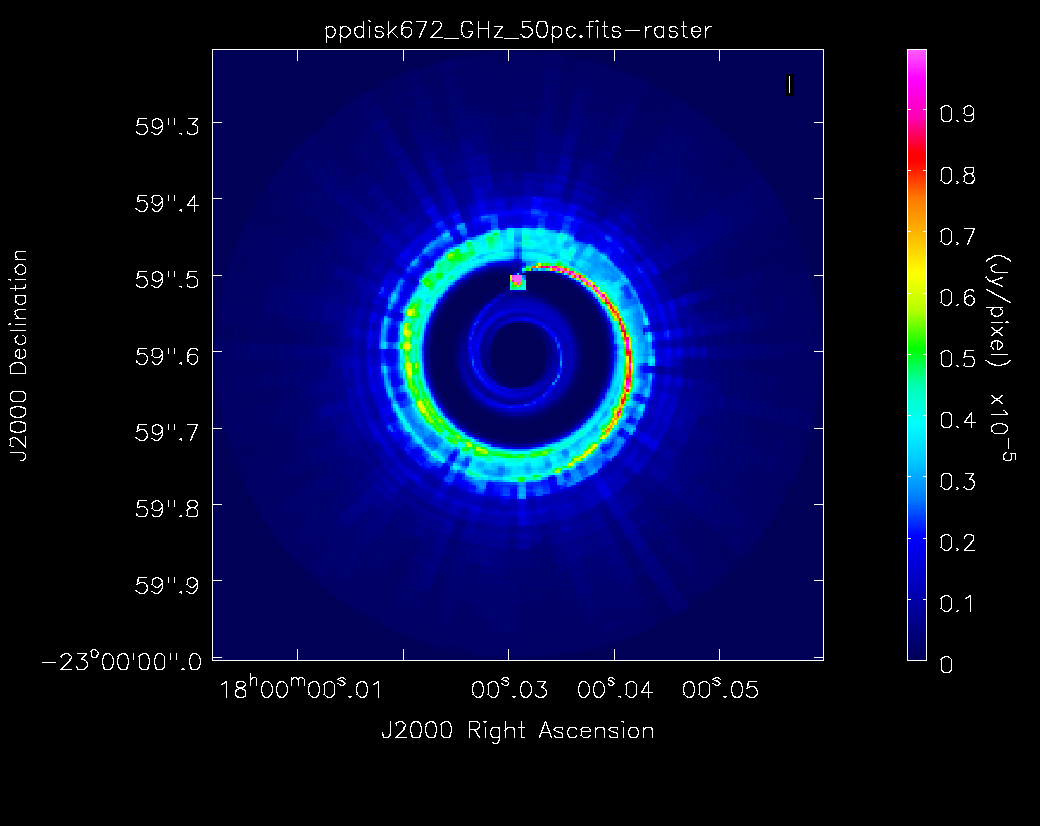 |
The ALMA version of the tutorial shows a way on how to derive the center of the image. We will use their results and specify direction='J2000 18h00m00.031s -22d59m59.6s' for all of our simulations. The image center can also be determined with the CASA viewer. Given that the VLA primary beams at the VLA frequencies are much larger than the image, the precise pointing direction center is less important.
We will use the simobserve and simanalyze tasks similar to the ALMA tutorials (in particular the plotted image sequence). The ALMA model, however, has a specified frequency of 672GHz and we will adapt it to work for VLA frequencies.
Note that simobserve has a few limitations. E.g. it cannot simulate different spectral windows. If this is desired, one needs to set up the simulation for each spw separately, and then use concat to merge all MeasurementSets. simobserve also has no option to add pointing errors to the simulated data. All VLA configurations and the VLA receiver temperatures are, however, accessible in simobserve.
Q-band, 128MHz bandwidth, noiseless image, 1h integration time, A-configuration, no deconvolution
Let's start with a simulation at 44GHz (Q-band), with a bandwidth of 128MHz, the largest possible bandwidth of a spectral window for the VLA. We will use the VLA A-configuration as it provides the resolution that is needed for the disk to be well resolved. To start with we do not add any noise to the data:
# In CASA
simobserve(project='psimvla1',
skymodel='ppdisk672_GHz_50pc.fits',
inbright='3e-5Jy/pixel',
incenter='44GHz',
inwidth='128MHz' ,
setpointings=True,
integration='2s',
direction='J2000 18h00m00.031s -22d59m59.6s',
mapsize= '0.78arcsec',
obsmode='int',
antennalist='vla.a.cfg',
hourangle='transit',
totaltime='3600s',
thermalnoise='',
graphics='both',
overwrite=True)
project: The name of our project is psimvla1. All data will be stored in a directory with the project name.
skymodel: The input model image in Jy/pixel units. We adjust the peak to a lower [math]\displaystyle{ 3\times10^{-5} }[/math]Jy/pixel value with the inbright parameter, as expected at a lower frequency. We also overwrite the fits header to assume that the model is valid for 44GHz with incenter and the bandwidth to 128MHz with inwidth
setpointings: will allow simobserve to derive the pointing positions by its own algorithm. Given that the primary beam at Q-band is about 1arcminutes (see the VLA [observational status summary], and the size of the model is less than an arcsecond, a single pointing will be adequate.
integration: To avoid time smearing, we follow the guidance for data rates in the VLA OSS and assume 2s per visibility integration.
direction: the center of the map. For a single pointing this is equivalent to the pointing center.
obsmode: int is used for interferometric data such as VLA observations.
antennalist: the VLA configuration antenna position file. The files are available in CASA via 'vla.x.cfg' where 'x' is the name of the array configuration. Here 'vla.a.cfg' is the VLA A configuration (the python command os.getenv("CASAPATH").split()[0]+"/data/alma/simmos/" shows the directory that contains all array configurations that are packaged in CASA)
hourangle: is used to simulate observations at a specific hour angle. We use 'transit' for culmination.
totaltime: This is the time on source.
thermalnoise: We leave this parameter empty for this noise-less simulation.
graphics: 'both' will show graphics on the screen and save them as png files in the project directory.
overwrite: True will overwrite previous results: be careful when running multiple setups as the files may have different names and only the files with the same names will be overwritten.
The output of the simulation is shown in Figs. 2 and 3. The first image is the sky coverage which shows clearly that the primary beam exceeds the size of the model image by far. The other ouputs are explained in the caption of Fig. 3.
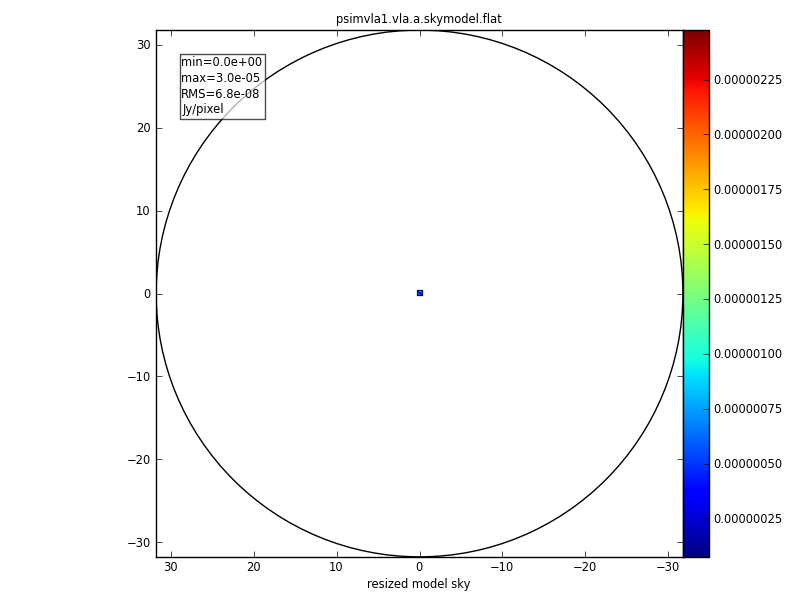 |
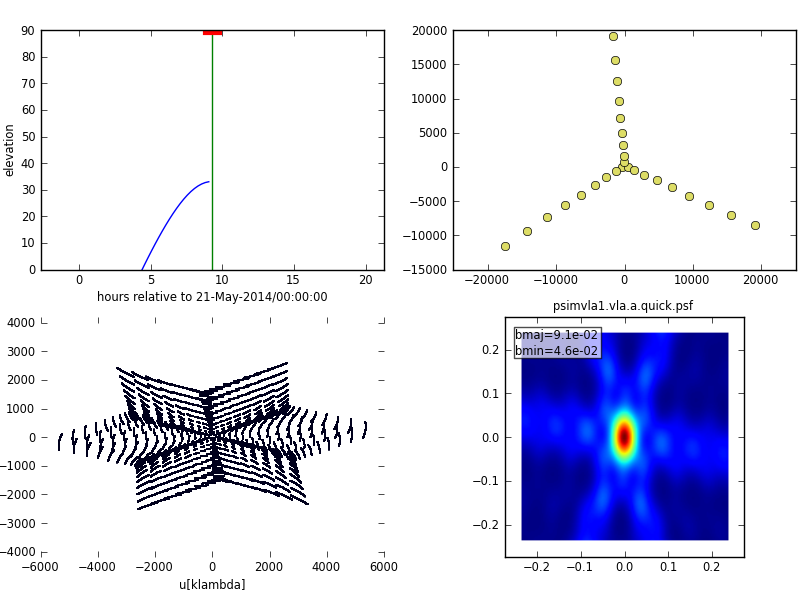 |
The task simanalyze can now process the newly created MeasurementSet and image the data:
# In CASA
simanalyze(project='psimvla1',
image=True,
vis='psimvla1.vla.a.ms',
imsize=[192, 192],
interactive=False,
niter=0,
weighting='briggs',
pbcor=False,
stokes='I',
analyze=True,
showuv=False,
showpsf=True,
showmodel=True,
showconvolved=True,
showclean=True,
showresidual=True,
showdifference=True,
showfidelity=True,
graphics='both',
overwrite=True)
project: The project (directory) name, same as in our call for simobserve.
image: True will image the visibilities with the following sub-parameters.
vis: The input MeasurementSet inside the project directory. Note that simobserve's notation is to use the project name appended by the antenna configuration file name.
imsize: the number of pixels for the image dimensions. We use 192 for each axis. By default simobserve will use the pixel size of the model image as the cell size for each pixel (3.11 milli-arcseconds in our case).
interactive: If set to True, the cleaning will be interactive to allow the step by step setting of clean boxes and clean depths (see the [VLA imaging topical guide]). We will turn this feature off.
niter: number of clean iterations. We start with a dirty map and set niter=0.
weighting: (cf. Image weighting schemes. We will use briggs which defaults to a robust = 0.5.
pbcor: If set to True the image will be primary beam corrected. In our case of a very large primary beam (see Fig. 1), primary beam correction will introduce very small corrections, so we turn it off.
stokes: The Stokes polarization to be calculated; we want Stokes I.
analyze: When set to True simobserve will perform basic analysis of the generated images and make hard copies of the following displays.
showuv: We set this to False as we already show the uv-coverage in the {simobserve} output (Fig. 3).
showpsf: Although we already have a plot of that in Fig. 3, we show it here again to have the comparison to the other plots.
showconvolved: creates a plot of the model convolved with the synthesized clean beam.
showclean: shows the deconvolved image (in our case we do not perform deconvolution, but show the plot anyways to be consistent with subsequent runs).
showresidual: a plot of the residual image after deconvolution.
showdifference: displays the difference between output cleaned image and input model sky image convolved with output clean beam, i.e. it shows remaining clean artefacts.
showfidelity: a fidelity image, as defined by [math]\displaystyle{ \frac{I}{|I-T|} }[/math] where [math]\displaystyle{ I }[/math] is the observed image and [math]\displaystyle{ T }[/math] the sky model, see the simanalyze CASAdoc help.
The resulting plots of our first simulation are shown in Fig. 4. Since this is a dirty image only (niter=0), the image and residual are the same dirty image. We also did not turn on any thermal noise and the image corruptions are all due to the incomplete uv-coverages of our simulations.
Q-band, 128MHz bandwidth, noiseless image, 1h integration time, A-configuration, cleaned
As a second step we will deconvolve this data set. This could be done inside the same project, but for a cleaner separation of our use cases, we will create a new MS with simobserve with a modified call of simanalyze:
# In CASA
simobserve(project='psimvla2', skymodel='ppdisk672_GHz_50pc.fits', inbright='3e-5Jy/pixel', incenter='44GHz', inwidth='128MHz' , setpointings=True, integration='2s', direction='J2000 18h00m00.031s -22d59m59.6s', mapsize= '0.78arcsec', obsmode='int', antennalist='vla.a.cfg', hourangle='transit', totaltime='3600s', thermalnoise='', graphics='both', overwrite=True)
simanalyze(project='psimvla2', image=True, vis='psimvla2.vla.a.ms', imsize=[192, 192], interactive=False, niter=1000, threshold='1e-4Jy', weighting='briggs', pbcor=False, stokes='I', analyze=True, showuv=False, showpsf=True, showmodel=True, showconvolved=True, showclean=True, showresidual=True, showdifference=True, showfidelity=True, graphics='both', overwrite=True)
The only difference to the earlier call of simobserve is our setting of niter=1000, threshold='1e-4Jy' which corresponds to a maximum number of 1000 clean iterations and a clean threshold of 0.1mJy. The threshold was chosen based on the previous image to be a few times above the rms of the image, and the niter is set large enough to reach the threshold. The residual image is now flatter as expected and the bulk of the sidelobes disappear.
 |
Q-band, 128MHz bandwidth, 4mm pwv, 1h integration time, A-configuration
We now add a precipitable water vapor of 4mm and a ground temperature for spillover of 270K. This can be achieved by the user_pwr and t_ground parameters. simobserve only adds thermal noise due to the sky brightness, but not phase noise due to pwv variations across the array. The sm.settrop tool can be used for the more sophisticated tropospheric models. A description is given in Corrupting Simulated Data.
# In CASA
simobserve(project='psimvla3', skymodel='ppdisk672_GHz_50pc.fits', inbright='3e-5Jy/pixel', incenter='44GHz', inwidth='128MHz' , setpointings=True, integration='2s', direction='J2000 18h00m00.031s -22d59m59.6s', mapsize= '0.78arcsec', obsmode='int', antennalist='vla.a.cfg', hourangle='transit', totaltime='3600s', thermalnoise='tsys-atm', user_pwv=4, t_ground=270.0, graphics='both', overwrite=True)
The simobserve output will be identical to Fig. 2 and 3 since we do not change any of the displayed parameters. Now let's analyze the MS:
# In CASA
simanalyze(project='psimvla3', image=True, vis='psimvla3.vla.a.noisy.ms', imsize=[192, 192], interactive=False, niter=1000, threshold='1e-4Jy', weighting='briggs', pbcor=False, stokes='I', analyze=True, showuv=False, showpsf=True, showmodel=True, showconvolved=True, showclean=True, showresidual=True, showdifference=True, showfidelity=True, graphics='both', overwrite=True)
The results are displayed in Fig. 6. The noise is dominating the image now, which is expected.
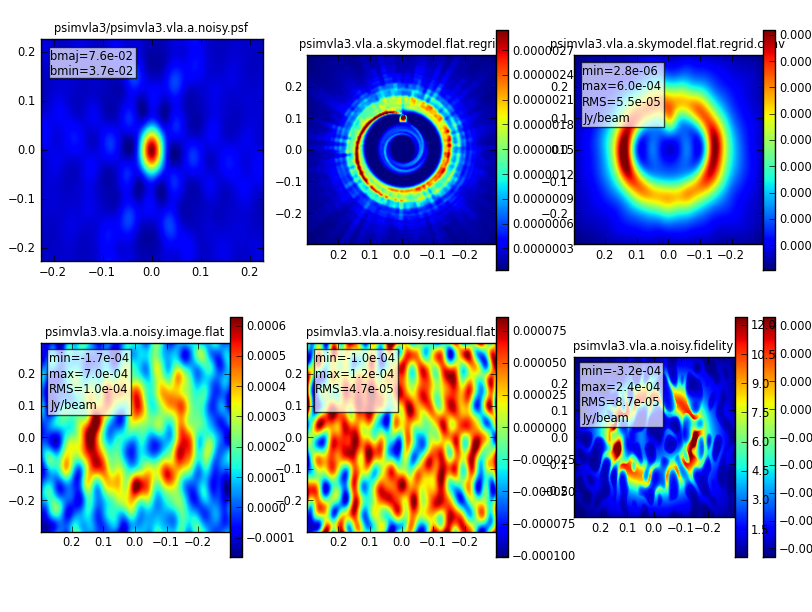 |
Comparison with the VLA Exposure Calculator
We can compare the simulation to the predicted VLA sensitivity via the VLA Exposure Calculator Tool (ECT) (Description). Using winter observing conditions (for good pwv), a medium elevation (cf. Fig. 3), 128MHz bandwidth at a frequency of 44GHz, the ECT predicts a beam size of 0.044" and which is compatible to our simulations (cf. Fig. 3 and 6). The ECT output is shown in Fig. 7.
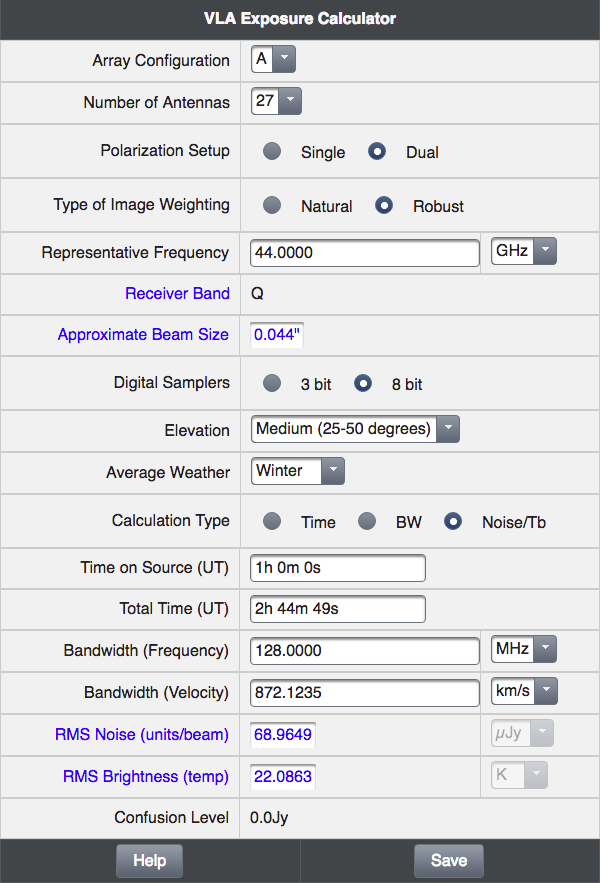 |
The rms provided in Fig. 6 is over the entire image and includes the source. It is therefore not representative to the thermal noise. To obtain a better noise figure, we produce an image with the same parameters as simanalyze, but with a larger image size directly via tclean. Since the briggs parameter in simanalyze defaults to robust=0.5, we will use the same value here:
# In CASA
tclean(vis='psimvla3/psimvla3.vla.a.noisy.ms', imagename='psim3-bigimage', imsize=[640, 640], cell='3.11e-3arcsec', specmode='mfs', gridder= 'standard', deconvolver='hogbom', weighting='briggs', robust=0.5, niter=1000, threshold='1e-4Jy')
opening the image in the viewer
# In CASA
viewer('psim3-bigimage.image')
and measuring the noise statistics away from the source (Fig. 8), gives a value of about 7e-5Jy/beam which is in very good agreement with the predicted noise figure of 6.9e-5 Jy/beam of the ECT.
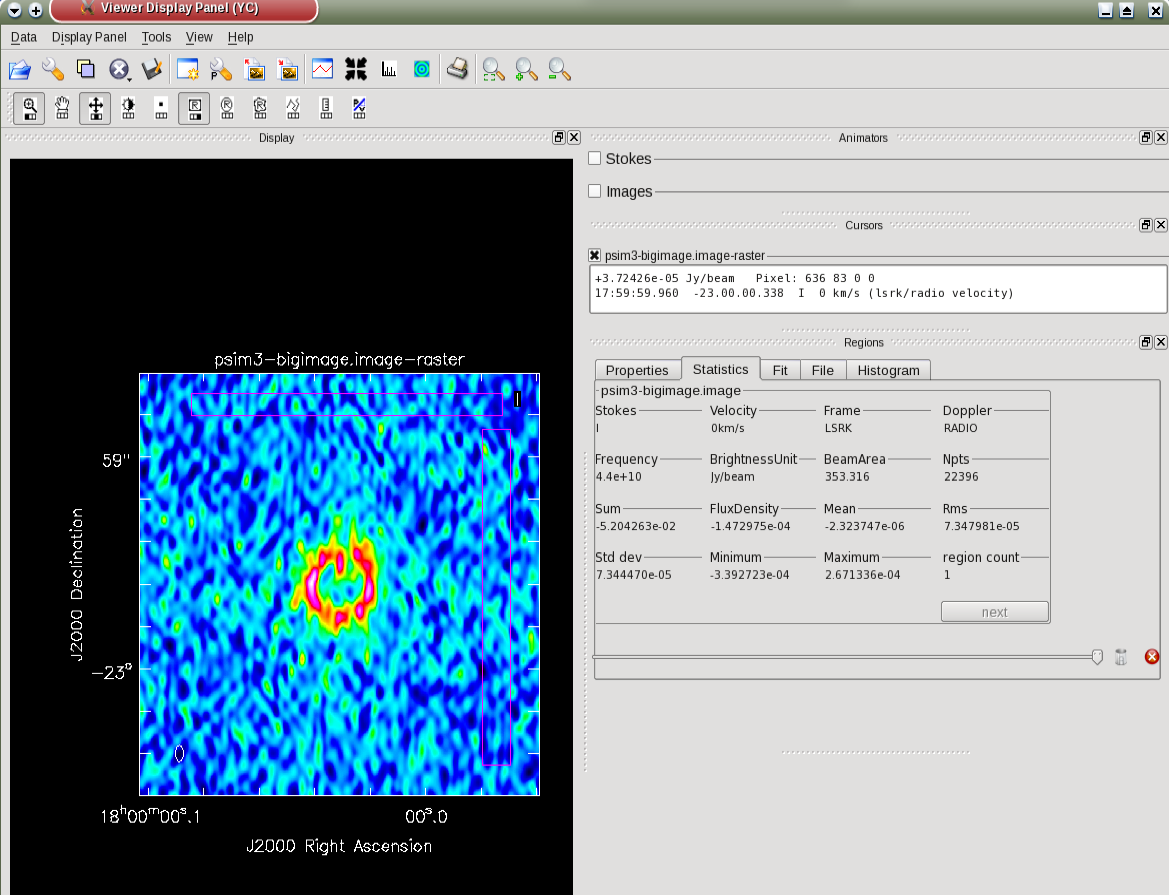 |
Q-band, 8GHz bandwidth, 4mm pwv, 1h integration time, A-configuration
To compensate for noise, we will extend our bandwidth from 128MHz to 8GHz. At this time, simobserve has no channelization so the simulation will not have the better uv-coverage that is obtained in multi-frequency imaging. Consecutive simulations with different spectral windows, and combined MSs, however, can achieve that and we will show how to obtain a multi-channel MS below. For large channel widths, one needs to be careful to not introduce bandwidth smearing. Our source is at the center of the image and bandwidth smearing will be minimal.
# In CASA
simobserve(project='psimvla4', skymodel='ppdisk672_GHz_50pc.fits', inbright='3e-5Jy/pixel', incenter='44GHz', inwidth='8GHz' , setpointings=True, integration='2s', direction='J2000 18h00m00.031s -22d59m59.6s', mapsize= '0.78arcsec', obsmode='int', antennalist='vla.a.cfg', hourangle='transit', totaltime='3600s', thermalnoise='tsys-atm', user_pwv=4, t_ground=270.0, graphics='both', overwrite=True)
The simobserve output again is identical to Fig. 3.
# In CASA
simanalyze(project='psimvla4', image=True, vis='psimvla4.vla.a.noisy.ms', imsize=[192, 192], interactive=False, niter=10000, threshold='5e-5Jy', weighting='briggs', pbcor=False, stokes='I', analyze=True, showuv=False, showpsf=True, showmodel=True, showconvolved=True, showclean=True, showresidual=True, showdifference=True, showfidelity=True, graphics='both', overwrite=True)
The image (Fig. 9) is clearly better defined, as expected from a broader bandwidth. We also decreased the cleaning threshold to 0.05mJy and added a few more iterations to reach this threshold.
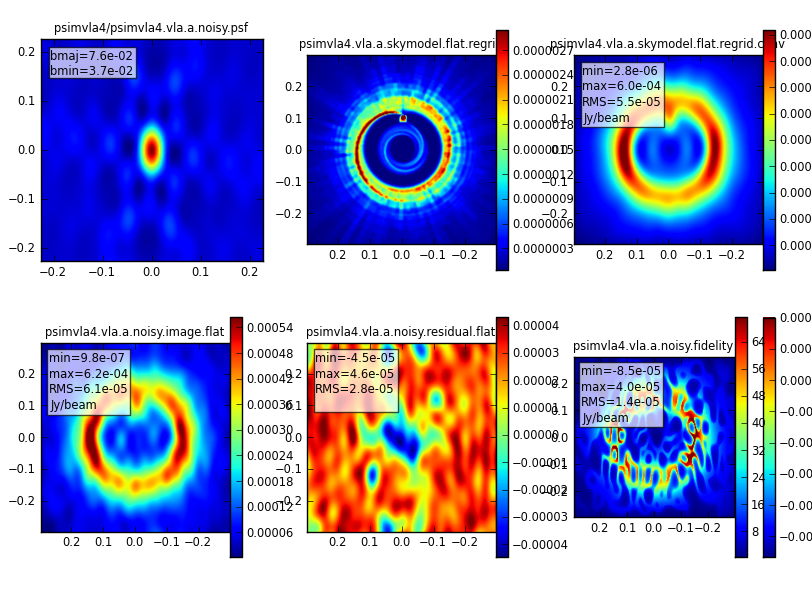 |
Multi-Term-Multi-Frequency Synthesis Imaging
In reality, the 8GHz bandwidth is not confined to a single channel but to many channels. This results in a spread out uv-coverage as it depends on the projected baselines expressed in number of wavelengths. Combining the channels in a multi-frequency synthesis (mfs), therefore does not only increase the sensitivity, but also the image fidelity. This leads to a better defined psf. Channelization and mfs imaging also reduces bandwidth smearing effects.
As mentioned above, simobserve, naturally, does not channelize the visibilities when the input image is not chanelized.
In the following, we will channelize the MS and, to show the procedure, we will also apply a spectral index of [math]\displaystyle{ S\propto\nu^{-1.5} }[/math] at the same time.
To start with, we need to produce a multi-channel model image. The following script converts our current model image from fits to the CASA image format with importfits. We then create 64 planes, apply the spectral index, and fix the headers accordingly to bring them into consecutive frequency order. Each channel is specified to a width of 128MHz (real VLA data would have typical channel widths of 2MHz). Finally, our individual planes are combined into a cube with the ia.imageconcat tool method.
# In CASA
importfits(fitsimage="ppdisk672_GHz_50pc.fits", imagename="ppdisk_Q_50pc.im")
stats=imstat(imagename='ppdisk_Q_50pc.im')
maximum=stats['max'][0]
ratio=3e-5/maximum
for x in range (0, 64):
y=40+x*0.128
immath(imagename="ppdisk_Q_50pc.im", mode='evalexpr', expr="IM0*"+str(ratio)+"*(("+str(y)+"/40)^-1.5)", outfile="ppdisk_Q_50pc_spx_"+str(x)+".im")
imhead(imagename="ppdisk_Q_50pc_spx_"+str(x)+".im", mode="put", hdkey="crval4", hdvalue=str(y)+"GHz")
imhead(imagename="ppdisk_Q_50pc_spx_"+str(x)+".im", mode="put", hdkey="cdelt4", hdvalue="128MHz")
comb=ia.imageconcat(outfile="ppdisk-combined_spx.im", infiles="ppdisk_Q_50pc_spx*.im", axis=3, relax=True, tempclose=False, reorder=True, overwrite=True)
comb.close()
Using this model cube in simobserve will produce the channelized visibilities:
# In CASA
simobserve(project='psimvla4mfs', skymodel='ppdisk-combined_spx.im', setpointings=True, integration='2s', direction='J2000 18h00m00.031s -22d59m59.6s', mapsize= '0.78arcsec', obsmode='int', antennalist='vla.a.cfg', hourangle='transit', totaltime='3600s', thermalnoise='tsys-atm', user_pwv=4, t_ground=270.0, graphics='none', overwrite=True)
simobserve and simanalyze assumes that if the model is a cube, the output will be a cube, too. In our case, however, we will produce a single multi-frequency synthesis continuum image so we have to use other, general CASA tasks for imaging and display.
Let's first have a look at the new uv-coverage. Each channel is displayed in a different color in Fig. 10:
# In CASA
plotms(vis='psimvla4mfs/psimvla4mfs.vla.a.noisy.ms', xaxis='Uwave', yaxis='Vwave',coloraxis='channel')
 |
simanalyze would assume that these data are to be imaged as a cube. Our aim, however, is to create a continuum image with the mfs technique, and, to recover the spectral index, we will use the Multi-term Taylor expansion in frequency (mtmfs, see CASAdocs Deconvolution Algorithms). We will use nterms=2 to derive the spectral index. The spectral index map, however, is fairly sensitive to the scales in the image. A regular Hogbom clean based on point sources, typically creates maps with too steep spectral indices when applied to extended emission. To avoid this effect, we therefore use the multi-scale algorithm with a range of scales:
# In CASA
tclean(vis='psimvla4mfs/psimvla4mfs.vla.a.noisy.ms', imagename='psimvla4mfs/8GHzmfs', imsize=[192, 192], cell='3.11e-3arcsec', specmode='mfs', gridder='standard', deconvolver='mtmfs', nterms=2, scales=[0,2,4,8,13,20,40], niter=1000, threshold='2e-4Jy', weighting='briggs', robust=0.5)
As before, we are not attempting primary beam corrections as the image is very small compared to the primary beam (cf. Fig. 2).
The images can be displayed with the viewer. Note that the image itself is called psimvla4mfs/8GHzmfs.image.tt0 (Fig. 11) and the spectral index map psimvla4mfs/8GHzmfs.alpha (Fig. 12). In Fig. 12 we also show the contours of the image on the spectral index map, to check for the signal-to-noise at each position.
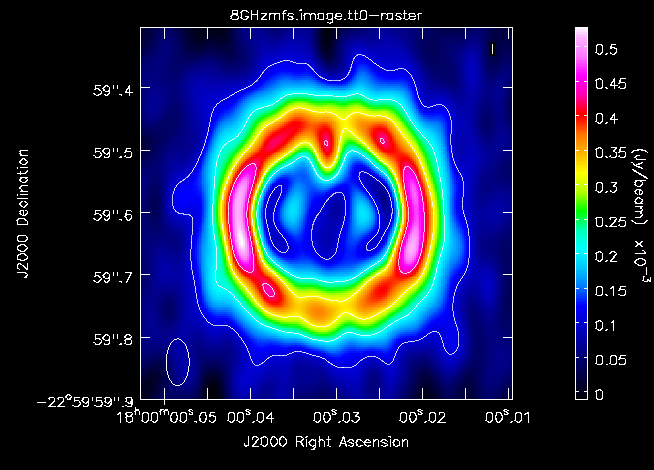 |
 |
As seen in Fig. 11, this method should produce a somewhat better fidelity than the non-mfs image shown in Fig. 9, although a direct comparison is difficult given the spectral index that we introduced. The spectral index map itself (Fig. 12), unfortunately, is dominated by noise, even at the brightest regions, partly due to the pwv that we assumed. This results in a relatively unreliable spectral index map overall, although the values scatter around the spectral index of -1.5 that we inserted earlier.
Q-band, 8GHz bandwidth, 4mm pwv, 4h integration time, A-configuration
Let's improve the depth of the observations even further by going to 4h on-source integration, via totaltime='14400s' . Given that mfs imaging only marginally improved the image, we will go back to using the original, unchannelized 8GHz bandwidth.
# In CASA
simobserve(project='psimvla5', skymodel='ppdisk672_GHz_50pc.fits', inbright='3e-5Jy/pixel', incenter='44GHz', inwidth='8GHz' , setpointings=True, integration='2s', direction='J2000 18h00m00.031s -22d59m59.6s', mapsize= '0.78arcsec', obsmode='int', antennalist='vla.a.cfg', hourangle='transit', totaltime='14400s', thermalnoise='tsys-atm', user_pwv=4, t_ground=270.0, graphics='both', overwrite=True)
Fig. 13 shows a better uv-coverage (lower left image) and the 4h observation is also marked by a wider red bar in the top left image. This also improved the shape of the psf.
 |
# In CASA
simanalyze(project='psimvla5', image=True, vis='psimvla5.vla.a.noisy.ms', imsize=[192, 192], interactive=False, niter=1000, threshold='2e-5Jy', weighting='briggs', pbcor=False, stokes='I', analyze=True, showuv=False, showpsf=True, showmodel=True, showconvolved=True, showclean=True, showresidual=True, showdifference=True, showfidelity=True, graphics='both', overwrite=True)
Given the expected deeper image we reduced the cleaning threshold to 0.02mJy, and the result is shown in Fig. 14. The image now is an almost perfect representation of the true sky model convolved with the clean beam.
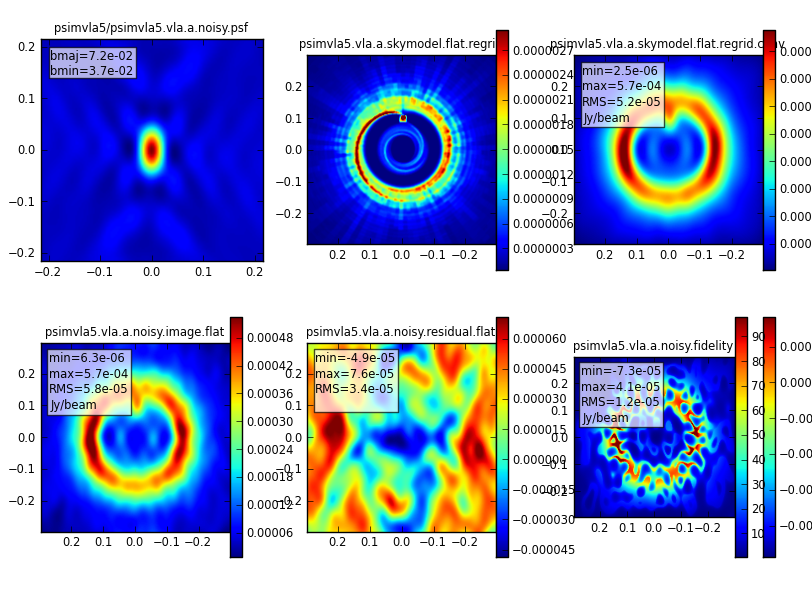 |
Comparison with the VLA Exposure Calculator
We compare again the simulation to the predicted VLA sensitivity via the VLA Exposure Calculator Tool (ETC) (Description). Using 8GHz bandwidth 4h on-source, and a low elevation due to the longer observations, the ECT predicts a rms of ~7.1[math]\displaystyle{ \mu Jy }[/math] (Fig. 15):
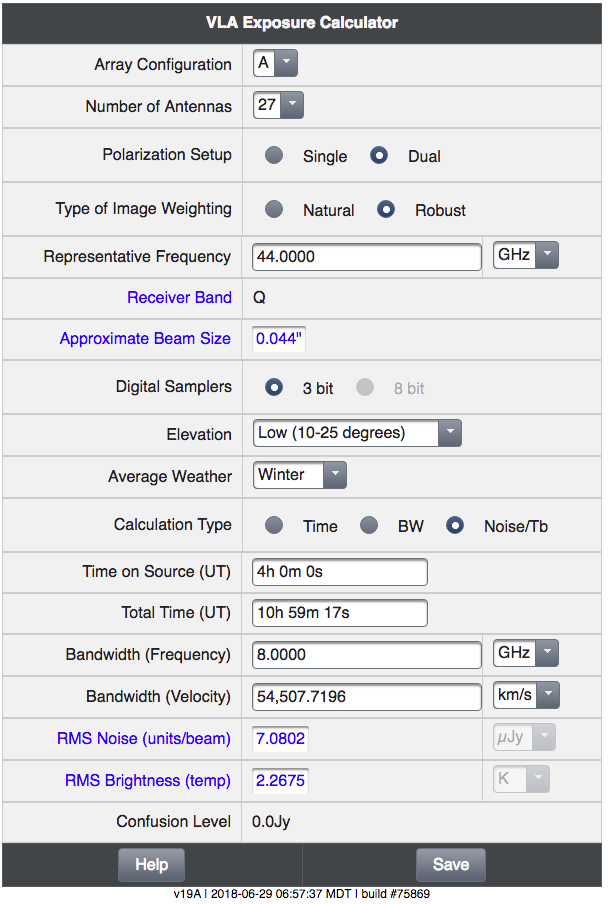 |
Note that the VLA exposure calculator switched to 3bit observing to accommodate the large bandwidth. The simulator, however, assumes 8bit samplers, which provide about 15% better sensitivity than the 3bit samplers of the VLA (For a discussion, see the VLA Samplers page).
Similar to the case of 128MHz bandwidth 1h case, we produce a larger image to be able to measure the image rms in a signal-free region:
# In CASA
tclean(vis='psimvla5/psimvla5.vla.a.noisy.ms', imagename='psim5-bigimage', imsize=[640, 640], cell='3.11e-3arcsec', specmode='mfs', gridder= 'standard', deconvolver='hogbom', weighting='briggs', robust=0.5, niter=10000, threshold='2e-5Jy')
opening the image in the viewer
# In CASA
viewer('psim5-bigimage.image')
and measuring the noise statistics away from the source (Fig. 16), gives a value of about 6mJy/beam which is slightly better but in reasonable agreement with the exposure calculator prediction.
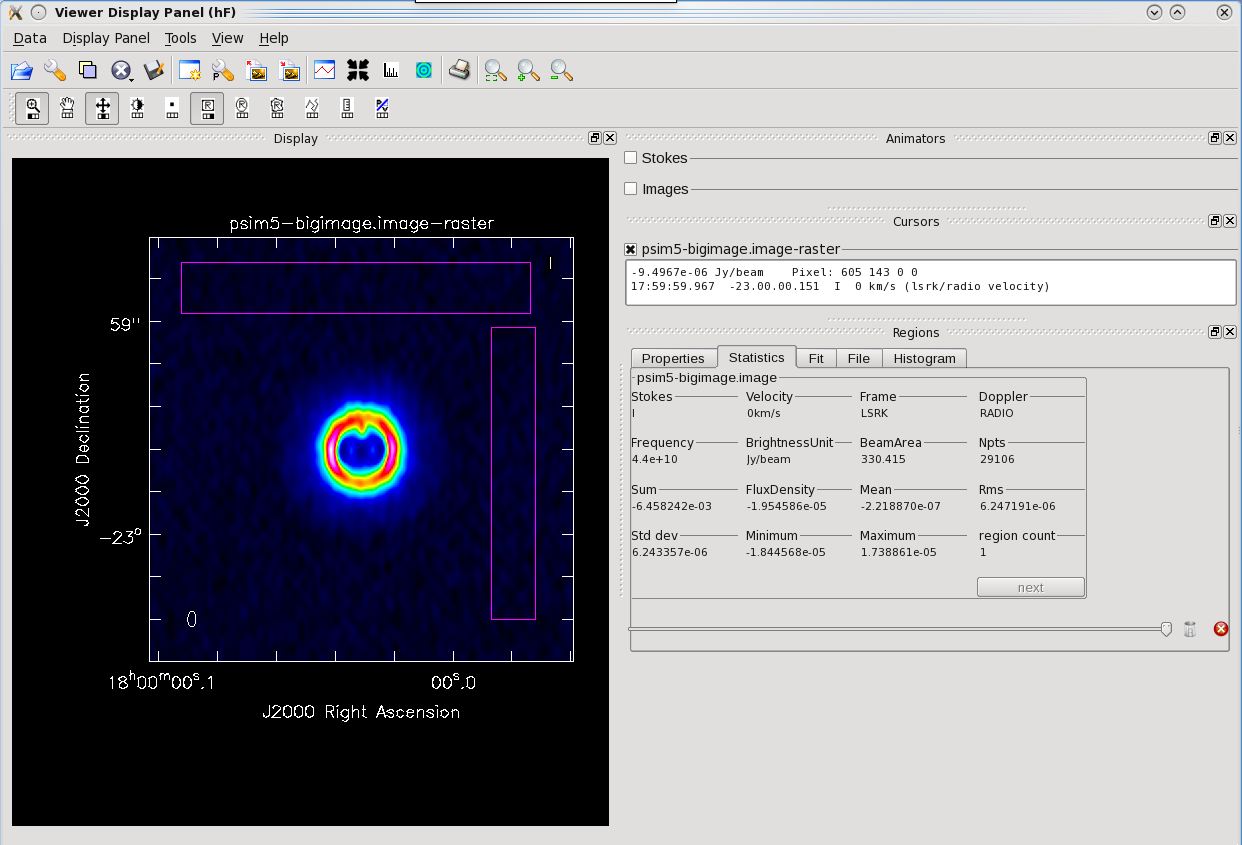 |
Q-band, 8GHz bandwidth, 4mm pwv, 1h integration time, C-configuration
Our last Q-band simulation will use a precipitable water vapor of 4mm again, but we will now simulate the observations with the VLA C-configuration (specified with the antennalist parameter).
# In CASA
simobserve(project='psimvla6', skymodel='ppdisk672_GHz_50pc.fits', inbright='3e-5Jy/pixel', incenter='44GHz', inwidth='8GHz' , setpointings=True, integration='2s', direction='J2000 18h00m00.031s -22d59m59.6s', mapsize= '0.78arcsec', obsmode='int', antennalist='vla.c.cfg', hourangle='transit', totaltime='3600s', thermalnoise='tsys-atm', user_pwv=4, t_ground=270.0, graphics='both', overwrite=True)
As expected, the extent of the uv-coverage decreases by a factor of about 10 and the synthesize beam size increases by the same factor, as seen in Fig. 17.
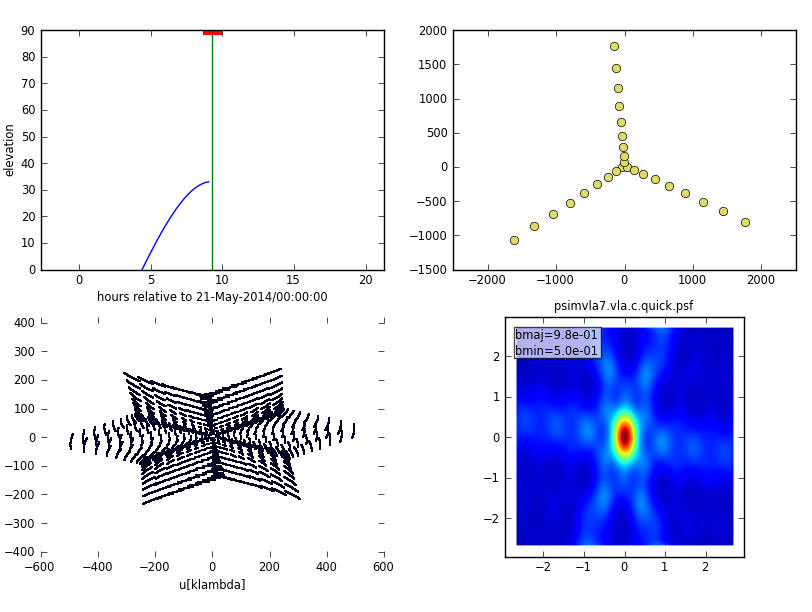 |
# In CASA
simanalyze(project='psimvla6', image=True, vis='psimvla6.vla.c.noisy.ms', imsize=[1728, 1728], interactive=False, niter=1000, threshold='1e-4Jy', weighting='briggs', pbcor=False, stokes='I', analyze=True, showuv=False, showpsf=True, showmodel=True, showconvolved=True, showclean=True, showresidual=True, showdifference=True, showfidelity=True, graphics='both', overwrite=True)
Note that the output filenames will now change and reflect C-configuration in their names. The resulting images are displayed in Fig. 18, where the images now look like a point source with the degraded resolution. The surface brightness sensitivity of the observations, however, increases and we can clean to a lower threshold of 0.1mJy. simobserve automatically detected that the beam is massively oversampled and that a larger image size will provide a better field of view.
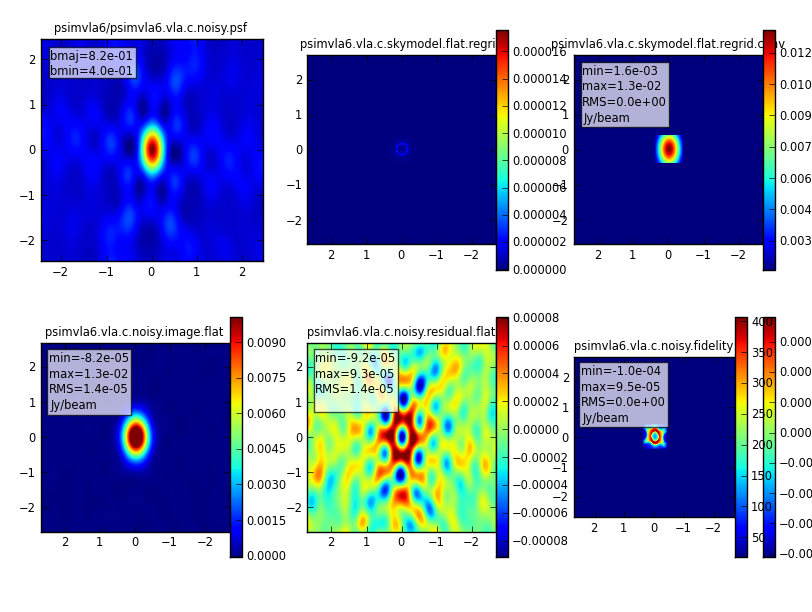 |
To combine the data of two different array configurations, we refer to the VLA Data Combination Guide.
X-band, 4GHz bandwidth, 4mm pwv, 1h integration time, A-configuration
Finally, we will go for a X-band (10GHz) A-configuration simulation. Since X-band has a maximum bandwidth of 4GHz, we will reduce it to this value. We will also lower the flux density of the model to 0.01mJy given that the intensity of the model will likely be lower, too.
# In CASA
simobserve(project='psimvla7', skymodel='ppdisk672_GHz_50pc.fits', inbright='1e-5Jy/pixel', incenter='10GHz', inwidth='4GHz' , setpointings=True, integration='2s', direction='J2000 18h00m00.031s -22d59m59.6s', mapsize= '0.78arcsec', obsmode='int', antennalist='vla.a.cfg', hourangle='transit', totaltime='3600s', thermalnoise='tsys-atm', user_pwv=4, t_ground=270.0, graphics='both', overwrite=True)
When expressed in wavelengths, the uv-coverage and synthesized beam are somewhere in between that of Q-band A-configuration and C-configuration as expected (Fig. 19).
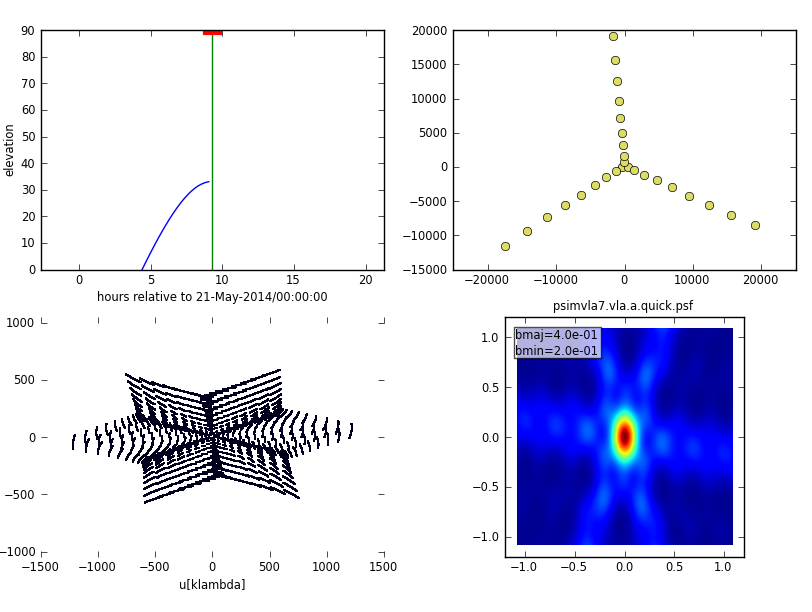 |
# In CASA
simanalyze(project='psimvla7', image=True, vis='psimvla7.vla.a.noisy.ms', imsize=[192, 192], interactive=False, niter=1000, threshold='3e-5Jy', weighting='briggs', pbcor=False, stokes='I', analyze=True, showuv=False, showpsf=True, showmodel=True, showconvolved=True, showclean=True, showresidual=True, showdifference=True, showfidelity=True, graphics='both', overwrite=True)
The larger primary beam of the X-band data is shown in Fig. 20, where the model image is barely visible in the center. The simulated images are shown in Fig. 21. The ring shape is still visible in the results although quite blurred. We note that the noise is considerably lower as expected from the lower band noise properties of the receiver and atmosphere. We adjusted the clean threshold accordingly. Again, simanalyze was overriding the image size as the psf would not have been adequately covered for the lower frequency.
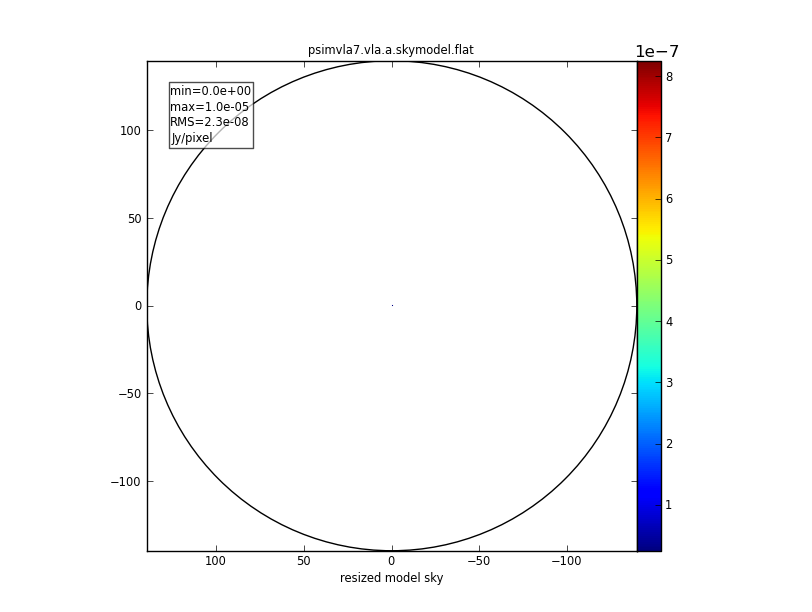 |
 |
Last checked on CASA Version 5.4.0.
